Snow White and the Seven Dwarfs: Diamond Collector's Set Blu-ray Movie
HomeSnow White and the Seven Dwarfs: Diamond Collector's Set Blu-ray Movie 
Limited Edition Collector Set / Blu-ray + DVDDisney / Buena Vista | 1937 | 83 min | Rated G | Oct 06, 2009
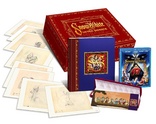
Movie rating
8.1 | / 10 |
Blu-ray rating
| Users | 0.0 | |
| Reviewer | 4.5 | |
| Overall | 4.5 |
Overview
Snow White and the Seven Dwarfs: Diamond Collector's Set (1937)
The fairy tale of Snow White, a beautiful young maiden cast into a deep sleep by her evil step-mother, but rescued from the dark magic spell through the love of handsome Prince Charming. The first animated full color sound motion picture.
Starring: Adriana Caselotti, Lucille La Verne, Stuart Buchanan, Roy Atwell, Pinto ColvigDirector: William Cottrell (I), David Hand, Wilfred Jackson, Larry Morey, Perce Pearce
| Family | Uncertain |
| Animation | Uncertain |
| Fantasy | Uncertain |
| Musical | Uncertain |
| Romance | Uncertain |
Specifications
Video
Video codec: MPEG-4 AVC
Video resolution: 1080p
Aspect ratio: 1.34:1
Original aspect ratio: 1.37:1
Audio
English: DTS-HD Master Audio 7.1 (48kHz, 24-bit)
English: Dolby Digital Mono (Original)
French: Dolby Digital 5.1 (640 kbps)
Spanish: Dolby Digital 5.1 (640 kbps)
Subtitles
English SDH, French, Spanish
Discs
50GB Blu-ray Disc
Three-disc set (2 BDs, 1 DVD)
DVD copy
BD-Live
Playback
Region A (locked)
Review
Rating summary
| Movie | 4.5 | |
| Video | 4.5 | |
| Audio | 4.5 | |
| Extras | 5.0 | |
| Overall | 4.5 |
Snow White and the Seven Dwarfs: Diamond Collector's Set Blu-ray Movie Review
Snow White arrives on Blu-ray in one of the most opulent deluxe sets ever released.
Reviewed by Jeffrey Kauffman October 10, 2009Note: My colleague Ken Brown did his usual excellently thorough job reviewing the standard Blu-ray release of Snow White here. Instead of reproducing his screencaptures, I thought it would be more useful to include pictures of the contents of this deluxe set. I highly recommend interested readers check out Ken's review, not only for his valuable insights, but also for the screenshot content it provides.
1939 is often cited as the apex of the Golden Age of Hollywood, a year when a laundry list of classic films was released, headlined by that incredible one, two punch from MGM, The Wizard of Oz and Gone With the Wind (yes, I know it was officially a Selznick release, but MGM distributed it). All of the other majors had their 1939 moments in the sun, too, but there’s a glaring omission of a studio that modern day audiences at least certainly would count among the biggies—Disney. The fact is in 1939, Disney was still on the outskirts of major studio-dom, though flush with the success of its first feature length animated film, Snow White and the Seven Dwarfs, but still several years away from achieving the oeuvre of classic films which defined its Golden Age. And so turning back the clock two years to 1937, we might see that year as the first “giant leap” for Disney up its own personal Everest, a year when Snow White was released to virtually no buzz and actual incredulity in some quarters (the wags had already dubbed the film “Disney’s Folly”). Was Walt a madman? How could he ever hope to entertain an adult audience with an 80 minute long cartoon? And certainly there was no way in H-double-hockey-sticks (we are in the squeaky clean world of Disney, after all) he would ever recoup the staggering million and half-plus he spent over almost four years of production on his first magnum opus.
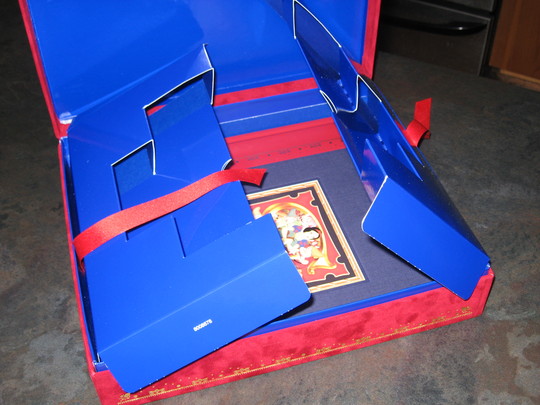
This beautiful box has only one problem--the inconvenient cardboard insert that must be opened to get to the hardcover book. Getting the insert back in the box is difficult.
Well, to paraphrase another great American icon, the rumors of Disney’s demise were greatly exaggerated. Snow White took 1937 audiences by surprise and by storm, offering a magical world of fantasy, fun and, yes, fright, to both children and their parents. No one had ever seen anything quite like this film which effortlessly mixed together a pretty standard mid-1930’s operetta format with some startlingly innovative imagery and finely drawn (pun intended) characters. If the intervening years haven’t been entirely kind to the outcome, revealing a sort of hoary creakiness underlying the film’s surface whimsy, Snow White and the Seven Dwarfs still stands as an epochal achievement not only in the individual history of the Disney studio itself, but in the annals of all film. Look past its very slight and occasional flaws and you’ll find that sense of wonder and beauty, tinged with just the right amount of terror, that defines the best in the Disney canon.
I won’t spend much time with a synopsis of Snow White, as the film has entered the public consciousness as few others before or since. Let’s instead spend a few words looking at the revolutionary techniques this film introduced to the motion picture lexicon, techniques that spilled over into live action features as well as, perhaps more expectedly, subsequent animated ones. This was the first Technicolor full length animated feature, and though Technicolor was slowly becoming more de rigeur in and around 1937 (notably at Paramount which was specializing in color location work in such big budget spectaculars as Trail of the Lonesome Pine and Ebb Tide), it was still considered a risky venture and one whose technical limitations and costs had to be weighed very carefully against any ostensible increase in profits. Disney’s artists didn’t need to be beholden to the omnipresent influence of the Kalmus family the way the major live action studios did, and were able to exploit a more vibrant and broader palette by simple virtue of the fact that they were hand coloring the film and not relying on the three strip process in and of itself to provide the various hues. This was also Disney’s first foray with his three dimensional “multi-plane” camera in a feature length setting, a utilization which brought literal depth to the image, helping to visually immerse the audience in a patently “false” image, something really quite remarkable when you think about it.
On a somewhat more subliminal level, this was Disney’s first real attempt to provide some psychological shadings to his characters, an attempt which removed the film from “mere” kiddie fare and helped to make it more palatable to adult audiences. Sometimes these attempts are shockingly declarative, as in the famous scene where Snow White’s fears as she gets lost in the forest manifest into one horrifying vision after another before her very eyes. At other times, they’re really remarkably subtle, though their intent has passed almost into the annals of camp in the intervening years, as in the wicked stepmother’s growing awareness of her own mortality and declining beauty.
Where this film really shines, however, is in the delightful character work, at least as far as the supporting dwarf characters go. If Snow White and the Prince are largely ciphers, the seven dwarfs are by their very design and naming sweetly individual creatures (yes, even Grumpy), who manifest their unique traits in charming little vignettes sprinkled throughout the film. Even more than the prototypical forest animals and birds, another common Disney trope, the dwarfs pave the way for untold classic Disney characters, whether animal, human, or neither, from Bambi’s Thumper to Tony (the waiter in Lady and the Tramp) to Lumiere in Beauty and the Beast, characters who provide not only comic relief, but also a lot of the heart and soul of each individual Disney feature. There's also usually at least one incredibly villainous character in a Disney animated feature, and Snow White's Evil Queen set the standard for what was to follow--both strangely alluring in her own nefarious way, but also downright scary (especially in her transforming scenes), easily one of the highlights (if also one of the lowlifes) of any Disney outing.
Finally, this film, though perhaps haltingly so, was the first to attempt a musical underpinning in a feature length animated format, offering a somewhat dated sounding operetta lite score, sung by Harry Stockwell (father of Dean) as the Prince and Adriana Caselotti as our title heroine. When the score works, as it does effortlessly in such classics as Heigh Ho, Whistle While You Work and Someday My Prince Will Come, it points the way forward to the seemingly unending series of Disney musical cartoons that have delighted audiences for generations, pieces which brilliantly integrated often incredibly lovely pieces of songcraft into what are often kind of stodgy libretti. If some of the other songs, like I’m Wishing, seem overly generic to modern ears, it can’t be discounted that one reason for that current familiarity is that these pieces were so often imitated in countless follow up projects (yes, even by the Disney studio itself).
Snow White and Seven Dwarfs is one of the all time classics of film history not just for its historical importance, but also for its lasting impact in both substance and style. This remarkably restored Blu-ray, especially in this unbelievably plush deluxe set, is reason alone to revisit the film if you haven't seen it recently, and perhaps more importantly, to introduce it to a new generation hungering for some awe and magic of their own.
Snow White and the Seven Dwarfs: Diamond Collector's Set Blu-ray Movie, Video Quality 
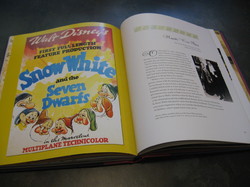
I think the best recommendation I can give for Snow White's astoundingly restored 1.37:1 AVC encoded image is my wife's reaction to it as she walked by the television. Not known for her love of high definition wonderment (you married guys probably know what I mean), she took one look at Snow White's crystalline image and simply said, "That's amazing--it's beautiful!" And, really, there's little more to add to that. The Disney restoration team has done an unparalleled job of upping Snow White's image quality ante to the point where it's truly impossible to imagine it getting any better. Colors are so bold in this most recent iteration of Disney's venerable classic that it's like watching a vintage 2009 film, not one from almost three quarters of a century ago. Detail is similarly sharp, with line detail brilliantly clear throughout the film. What impressed me most about this Blu-ray was its texture. Certain scenes are virtually painterly, beautifully deep and almost redolent of brushstrokes (look at the omnipresent candles and the light they give off for a good example). Contrast that with the sharp but inherently two-dimensionality of some of the costumes the characters wear. It's a study in different artistic techniques (and Walt's commentary goes into some detail about having to shift various artists around to different tasks during the long production period), and one which this Blu-ray brings out with optimum proficiency. About the only complaint I can offer, as stupidly minor as it is (and one that is inherent in the source elements, I'm quite sure), is the minor debris, which looks like faint smudging, that evidently accumulated on the multi-plane shots. You'll notice it in the sky of the first forest scene, for example (and something quite similar attended the Blu-ray release of the much more recent Sleeping Beauty).
Snow White and the Seven Dwarfs: Diamond Collector's Set Blu-ray Movie, Audio Quality 
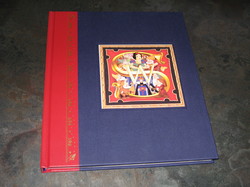
The Disney "imagineers" have provided a really glorious DTS HD-MA 7.1 upgrade to the original mono track (which is also available, albeit via a lossy Dolby Digital track). While this may not be the totally immersive experience that some audiophiles may unrealistically expect from a film this old, I was consistently impressed with the intelligence with which these source elements have been scrubbed and repositioned for at least the semblance of a surround experience. The most remarkable part of this new 7.1 upgrade is the sonic fullness of the music. Gone is the overly boxy sound of even the most recent DVD version of this film, and a whole new level of nuance can be heard, especially in the wonderful underscore. Dialogue is all clear and crisp. Directionality is not overwhelming throughout Snow White, but there are some very impressive sequences here, notably the first "nightmare" forest scene and, later, the big storm scene, both of which have some nice rumbling LFE and some very smart panning of sounds.
Snow White and the Seven Dwarfs: Diamond Collector's Set Blu-ray Movie, Special Features and Extras 
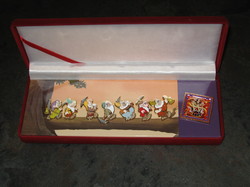
There is such an abundance of bonus features in this gorgeous box that it presents a literal embarrassment of riches for the discriminating collector. Let's start with the box and its contents itself, and then move on to the disc-specific supplements themselves.
This limited collector's edition arrives in a beautifully hefty red velour covered box which beautifully reproduces Snow White's original logo in gold lettering on the top. Filigreed gold fleurs-de-lis ornament the sides of the box. The box lid is louvered to lift easily up (though it appears it's only the velour covering that attaches the lid to the box itself, not auguring well for repeated openings and closings) to reveal several items inside:
• The 3 disc Blu-ray/DVD combo pack itself, more about which later.
• An envelope containing eight lithographs of original line art of Snow and her septet of helpers. These are what look to be draft drawings, with small notes appended to most of them, all of them in black and white, with just a couple of test patches of color on a couple of them.
• A red velour covered jewelry box containing eight cloissoné pins of Snow and the dwarfs. Each of the dwarf pins are of their actual characters, cut to their body shapes, while the Snow pin is a larger square with an image of Snow and a large "S" and "W" enveloping the image.
• A beautiful hardbound 160 page book, containing a wealth of illustrations and some very interesting content. There's a review of the original fairy tale as well as Walt's adaptive genius, all in the context of the early Disney studio output. Another long chapter deals with character design, including some jettisoned "looks" for various characters, all within the framework of the mythos that Disney was developing not only for this project in particular but really for his studio's output as a whole. Finally there's some great content about the film's release and the multi-decade merchandising mania that followed in its wake.
One quick caveat about this box's structure before I move on to the disc extras. While the box itself seems sturdy enough (with the possible exception of how the lid is attached to the body of the box), the layout of the items within the box is not handled extremely well, in my opinion. The lithographs and Blu-ray lie in an opening on top of the jewelry box. All three of those items must be removed and then a rather clumsy cardboard insert which houses them must be opened (much like a book) to reveal the hardback book underneath. Getting this cardboard insert folded back into the box proper is something of a task, as the four edges, which tend to bow outward, must be simultaneously held and fitted to make the whole thing work. There are also two satin ribbons which lie over the contents. These serve no function as I quickly discovered when I pulled on them and actually dislodged the left one from the box (it's held on by some of that sticky "sap" like glue that often is on cardboard backing material for BD's). Unlike the recent Wizard of Oz deluxe boxed set, the ribbons do not lift up any additional content, so just set them out of the way to get to everything inside the box.
Disc One contains the main feature as well as a really interesting commentary cobbled together from years of Walt himself talking about the project (one source element sounded to me like it must have been recorded on an old propeller plane due to the omnipresent buzz in the background, or there's some significant low end flutter on the original recording). Knitting these reminiscences together is the equally informative bridging commentary of historian John Canemaker. Also included on Disc One are the following HD extras:
• An eight minute preview of Disney's soon to be released The Princess and the Frog. This looks like a promising new feature, with an obvious nod to the classic Disney animation look.
• Snow White Returns, a look at the aborted sequel to the original.
• Two long Deleted Scenes involving the dwarfs, totaling around 11 minutes.
• Disney View a kind of silly, but enjoyable, extra that replaces the standard black pillar boxes with illustrations.
• BD Live, as it did with Sleeping Beauty, has some fun with your local weather—listen to the talking mirror for a variety of caustic comments. The mirror also "knows" if you're accessing the BD for the first time or returning. One semi-hidden extra that's quite useful is a self-bookmarking functionality that will give you the option to start the film from where you left off, at least if you've been listening to the commentary.
Rounding out Disc One are three family friendly games and a pretty lamentable pop update music video of Someday My Prince Will Come.
Disc Two contains a wealth of HD content, the bulk of which is contained in the exhaustive (and exhausting) soubriquet of Hyperion Studios (the name of the original home of the Disney crew). This is really one of the most labyrinthine collections of extras imaginable, made navigable only by the really necessary index which also conveniently checks off locations you've visited, if not thoroughly explored. The mass of this content, divided into 13 "rooms," is overwhelming at times, but I'll try to sum it up concisely.
• Hyperion Exterior includes around 30 minutes spread over three featurettes that document the early days of the Disney enterprise, including the genesis of Snow White.
• Story Room contains a little over 15 minutes of material, including a complete Disney cartoon, Babes in the Woods, based on another patently scary fairy tale, "Hansel and Gretel." There's a wealth of material on Disney's writers in this section, including some kind of funny anecdotes about Walt's working relationships with his charges. Also in this section are two huge image galleries, one of storyboard images and another of abandoned ideas which never made the final cut of the film.
• The Music Room is a pretty self-evident collection of another 15 minutes of items related to the scoring of Disney films, and Snow White in particular. Another full length Disney cartoon, The Skeleton Dance, is included here.
• The Art Department offers around 26 minutes dedicated to the artists who brought Snow White to life, with some really interesting looks at the antecedents which influenced them. Yet another full length cartoon is featured here, the very fun Music Land, offering hope for those of us who have worked in both the classical and jazz musical idioms. There are also two more galleries, one dedicated to the development of the images of the film, and another one focusing solely on artist Gustav Tenggren.
• Character Design offers only one short six minute feature, a sort of silly reenactment of Walt's discussions with the artists. Two more (minimal) galleries round out this room, one dedicated to character design, and another to color tests.
• Background and Layout is best in two exhaustive galleries on each subject. A brief featurette gives basic information on what this department accomplishes.
• Animation Department is one of the "larger" rooms, with 34 minutes of content detailing the animators' exploits not only on Snow White itself, but also with each other in the office. Two cartoon shorts are included in this section, Goddess of Spring and Playful Pluto.
• Live Action Reference is a short but fascinating look at how Disney pioneered the use of filming live actors to both inspire his artists and, frankly, let them rotoscope (a sort of high-tech tracing technique) various actions. None other than the famed danced Marge Champion provided some of the movement for Snow's animated version. There's also some background on voice casting in this section, as well as an image gallery of the live action reference tests.
• Sweatbox is the perhaps understandable appellation given to the room where Disney would screen in process scenes with his staff, deciding on what was working and what wasn't. This brief (about 5 minutes) section does include a cut segment from Snow White.
• Ink and Paint is another short set of featurettes that may have feminists up in arms around the distribution of duties at the Disney operation. Also included is another Silly Symphony, the Oscar winning Flowers and Trees, as well as another image gallery.
• Camera Department provides around 10 minutes of featurettes on Disney's technological innovations, as well as another 9 minutes of the multi-plane wonders of The Old Mill, one of the studio's most famous shorts.
• Sound Stage may only have a couple of minutes on its subject matter, but it also contains the epochal Steamboat Willie, Disney's first foray into the use of synchronized sound.
• Walt's Office offers a touching, if paltry two minutes' worth, retrospective of what it was like to work with the great man himself. Rounding out this final room are galleries devoted to PR materials and production stills.
If that isn't enough for you, Disc Two also features a nice retrospective documentary called The One that Started it All, as well as several items ported over from the last DVD release, including the documentaries Disney Through the Decades and Animation Voice Talent, as well as Dopey's Wild Mine Ride game and Heigh Ho, a singalong feature.
Finally for you luddites without Blu-ray players (which begs the question as to why you're reading this review), there's a third disc featuring the film and bonus content on SD-DVD. Joking aside (that luddite comment was a joke, I promise), I applaud this recent Disney "combo pak" strategy. We have two Blu-ray players here at home, but the kids often want to watch features on one of our older DVD players and this kind of thoughtfulness on Disney's part means the younger set isn't left out in the cold.
Snow White and the Seven Dwarfs: Diamond Collector's Set Blu-ray Movie, Overall Score and Recommendation 

There are a lot of studios that go back to the well with a perhaps predictable regularity. Disney can certainly be faulted for this propensity, but unlike other studios (Acorn springs to mind), they consistently revisit their catalog titles to upgrade not only image and audio but also to provide new supplemental content. That method is fully, abundantly on display in this magical Diamond Edition, a really resplendent velour treasure chest that contains not just a classic film in a sparkling new presentation, but truly unbelievable extras on both the discs themselves, as well as within the box. This is an admittedly pricey alternative to the standalone disc package, but Snow White aficionados are going to be as happy as, well, Happy to pore over the contents of this impressive set.
Other editions
Snow White and the Seven Dwarfs: Other Editions

Snow White and the Seven Dwarfs
Diamond Edition | DVD Packaging
1937

Snow White and the Seven Dwarfs
Diamond Edition
1937

Snow White and the Seven Dwarfs
Collector's Book Set / DVD Packaging
1937

Snow White and the Seven Dwarfs
Diamond Edition | Empty Case
1937

Snow White and the Seven Dwarfs
Plush Gift Set
1937

Snow White and the Seven Dwarfs
The Royal Wedding Collection
1937

Snow White and the Seven Dwarfs
The Signature Collection
1937

Snow White and the Seven Dwarfs
The Signature Collection / Exclusive Lenticular Packaging
1937

Snow White and the Seven Dwarfs
The Signature Collection / 32-page Story Book
1937

Snow White and the Seven Dwarfs
Gold holiday edition
1937

Snow White and the Seven Dwarfs
85th Anniversary Edition
1937

Snow White and the Seven Dwarfs 4K
1937

Snow White and the Seven Dwarfs
w/ Pin / Disney100
1937

Snow White and the Seven Dwarfs 4K
Disney100 | Limited Edition
1937

Snow White and the Seven Dwarfs 4K
1937
Similar titles
Similar titles you might also like

Sleeping Beauty
Anniversary Edition | The Signature Collection
1959

Beauty and the Beast
25th Anniversary Edition | The Signature Collection
1991

The Princess and the Frog 4K
Ultimate Collector's Edition
2009

Tangled
2010

The Little Mermaid 4K
Anniversary Edition | The Signature Collection
1989

Cinderella 4K
Ultimate Collector's Edition
1950

Frozen
Collector's Edition
2013

Frozen II 4K
Ultimate Collector's Edition
2019

Cinderella II: Dreams Come True
2002

Fantasia 2000
1999

Aladdin 4K
The Signature Collection | Ultimate Collector's Edition
1992

Fantasia 4K
1940

Alice in Wonderland
60th Anniversary Edition
1951

Pinocchio
The Signature Collection
1940

Cinderella III: A Twist in Time
2007

Peter Pan
Anniversary Edition | The Signature Collection
1953

Moana
2016

Strange Magic
2015

Tinker Bell
2008

Pocahontas
1995